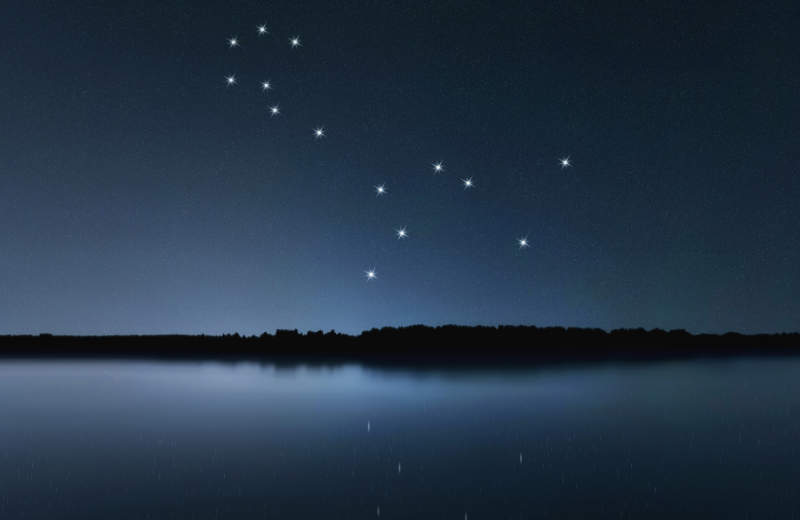Cetus is an intriguing constellation with a story that dates back to ancient mythology. Whether you’re an astronomy enthusiast or just curious about the secrets of the cosmos, understanding the Cetus constellation can add a new layer of wonder to your stargazing experience. So, what makes Cetus so special? Let's find out.
Jump to:
Recommended for you!
Best SellersWhat is the Cetus Constellation?
The Cetus constellation, also known as the Whale Constellation, is a vast expanse of stars located in a region of the sky known as the celestial sea. It sits near other water-themed constellations, such as Pisces and Eridanus. Cetus is often depicted as a sea monster or a giant whale and is one of the largest constellations in the night sky. Its name, Cetus, translates to "sea monster" or "whale" in Latin, reflecting the creature’s formidable reputation in Greek mythology.
What Does Cetus Look Like?

Spotting Cetus in the sky can be an exciting challenge for stargazers. The constellation stretches across a considerable area, with its brightest stars loosely forming the outline of a sea monster or whale. The stars of Cetus aren’t particularly bright compared to some other constellations, but the distinctive pattern is quite memorable once you know what to look for. The head of Cetus is marked by a pentagon-like formation of stars, while the body extends outward in a zigzag fashion.
How Far is the Cetus Constellation from Earth?
While constellations are patterns formed by stars that can be thousands of light-years apart, most of Cetus’s notable stars lie within a few hundred light-years from Earth. For instance, Mira, one of Cetus's most famous stars, is approximately 300 light-years away. These vast distances remind us just how immense and awe-inspiring the universe truly is.
The Cetus Constellation Myth

Cetus appears in Greek mythology as the sea monster sent by Poseidon to ravage the kingdom of Ethiopia. According to the legend, Queen Cassiopeia had boasted about her beauty, claiming she was more beautiful than the sea nymphs. Angered by her arrogance, Poseidon unleashed Cetus to punish the kingdom. To appease the monster, the king was forced to sacrifice his daughter, Andromeda. However, the hero Perseus arrived just in time, using the head of Medusa to turn Cetus into stone and save Andromeda.
Cetus's Stars
The Whale Constellation boasts several fascinating stars, each with its own unique characteristics. Let’s explore some of the most notable ones:
- Mira (Omicron Ceti): Mira is perhaps the most famous star in Cetus. It’s a pulsating variable star, meaning it regularly changes in brightness. Mira’s brightness variation was one of the first of its kind to be discovered, earning it the nickname "The Wonderful." The star fluctuates between being easily visible to the naked eye and becoming so faint that it requires a telescope to see.
- Deneb Kaitos (Beta Ceti): Deneb Kaitos is the brightest star in Cetus and represents the tail of the sea monster. The name Deneb Kaitos means "tail of the whale" in Arabic. It’s a giant star, much larger and brighter than our Sun, sitting around 96 light-years away from Earth.
- Tau Ceti: Tau Ceti is another notable star, particularly because of its similarity to our Sun. It’s one of the closest stars to our solar system, located just 12 light-years away, and has been a subject of interest in the search for habitable planets.
Nebulae in the Cetus Constellation

Cetus is also home to some fascinating deep-sky objects. One of the most interesting is the Cetus A galaxy, also known as Messier 77 (M77). It’s a barred spiral galaxy located about 47 million light-years away and one of the brightest galaxies in the sky. M77 is easily visible through small telescopes and is a popular target for amateur astronomers.
Finding Cetus in the Sky
Cetus is best viewed during the autumn and winter months in the Northern Hemisphere, with peak visibility occurring between October and January. During this time, it rises higher in the night sky, making it easier to observe.
Locating Cetus
To locate Cetus, begin by identifying nearby constellations as reference points:
- Look Near Pisces and Eridanus: Cetus lies close to these constellations. Finding Pisces or Eridanus first can help guide you to the distinctive zigzag pattern of Cetus’s stars.
- Use a Star Map or Stargazing App: Since Cetus’s stars can be faint, especially in areas with light pollution, a star map or a reliable stargazing app can be invaluable. These tools will help pinpoint Cetus's location in the sky.
Viewing Cetus with Binoculars or a Telescope
- With Binoculars: Binoculars can help make Cetus's stars clearer, especially if you are viewing from an area with light pollution. They will bring out the constellation’s dimmer stars, making the pattern easier to trace.
- With a Telescope: A telescope will provide a more detailed view, allowing you to explore some of the fascinating stars and celestial objects within Cetus, like Mira or Tau Ceti.
Best Viewing Conditions
For the best experience observing Cetus, head to a dark location away from city lights on a clear, moonless night. The lack of artificial light will allow the constellation’s fainter stars to become more visible.
Recommended for you!
Best SellersFun Facts About Cetus
- Not a Zodiac Constellation: Despite its size, Cetus is not part of the zodiac, but it does sit close to the zodiac constellations Pisces and Aries.
- Astronomical Significance: Cetus hosts some of the closest stars and exoplanets to our solar system, making it a point of interest for amateur and professional astronomers.
- Cetus Sea Monster: In addition to being called the Whale Constellation, Cetus is often referred to as the Sea Monster due to its mythical background.
- Gigantic Star: The star Mira is so large that if it replaced the Sun, its outer layers would extend past the orbit of Mars.
Study Astronomy for £29
If you’re intrigued by constellations like Caelum and want to learn more about the wonders of the universe, why not take your curiosity to the next level with our Astronomy Diploma Course? This course offers a detailed understanding of the universe, from constellations and star types to the fundamentals of space observation. Perfect for all budding astronomers, the course is available for a discounted price of £29.













